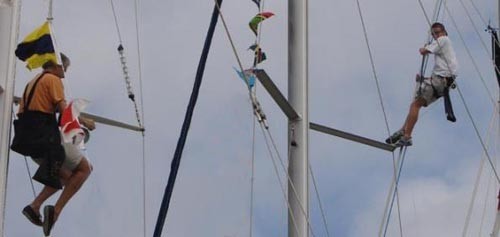Another mast-climbing death - Nine Rules so you are not next..
by Nancy Knudsen on 16 Jun 2009

Check the rigging while still in the dock - to avoid having to do it at sea SW
Last week another death was caused by a fall from a nine metre mast in Ontario USA. The sailor fell out of his sling while he was being hoisted and his head hit a spreader as he fell. He was pronounced dead at the scene.
Many old sailors have stories of watching horrified as someone falls to their death from the top of a mast.
Some years ago sailors getting ready for the Sydney to Hobart yacht race saw a man fall from the top of his mast when some part of his gear gave way. He landed, not on the yacht but on the slipway, and died instantly. A falling man is 'lucky' if the yacht is at sea and his fall puts him in the water.
In another, more comical than serious incident, a man British sailor recently spent three and a half hours in the rain waiting for the fire brigade to work out a way to get him down when his pulley system jammed while he was at the top of his 13 metre mast. On that occasion the existence of a nearby 10 metre lock allowed the fire fighters to sink the yacht, then topple the boat slightly with a rope and place a ladder against the mast for the embarrassed sailor. Quoted local Avon firefighter - 'I have never had a rescue like this before!'
Climbing the mast can be one of the most challenging of prospects, particularly at sea, and particularly in a bad sea.
So here are some safety reminders, to preserve, not only the life of the climber, but also the safety of those below:
1. Have on board, and always use, a bosun's chair - this is NOT the time to improvise.
2. ALWAYS use a safety line - a second line, a halyard, so that if the first line or its connectors fail, the second line will take the load.
3. Wear deck shoes, to prevent injuring your feet as you are winched up, or while working.
4. Prepare a separate bag in which your tools are held.
5. Take up third light line. Once in place at the spreader or top of the mast, have the tools sent up. This means that the tools cannot get in the way while you are being hoisted. This also has the added advantage that, if you need an extra tool, it can be sent up.
6. Those doing the hoisting should do it at a consistent speed so that the mast climber can easily negotiate extrusions on the way.
7. While the mast climber is working, those underneath should stay clear to avoid being hit if the worker drops a tool.
8. At sea, wear a harness and attach yourself to the mast so that you cannot swing away as the mast sways, and it leaves both hands free for working. - Always remember that the yacht acts like a fulcrum. A small movement of the deck can result in a swing of several metres at the top of the mast.
9. Go up the mast and check the gear in the dock before an ocean voyage, to avoid, hopefully, having to make the climb while at sea.
Aids to climbing the mast:
Mast steps(photo right):
Mast steps, either fixed or folding, can give extra security and make climbing the mast easier. They can be profitably used in conjunction with a bosun's chair and line, giving the climber more control over the operation. They are good also in coral waters to spot the way through reefs, and I highly recommend them if travelling in the tropics.
Top-Climber(photo above):
This is an excellent system, particularly if there is no help available. It looks a little like a bosun's chair combined with a mountain climber’s harness. Both the seat and the separate foot straps attach to a line that is raised taut with a halyard. Each has a one-way line jammer that ensures neither the seat nor foot straps can slip downward unless intentionally released.
To operate, the climber stands in the foot straps and raises the seat up, then sits back into the seat and raises the foot straps up a foot or more, then stands again and raises the seat, and so on up the mast. It is still advisable to use a safety line.
If you want to link to this article then please use this URL: www.sail-world.com/57917